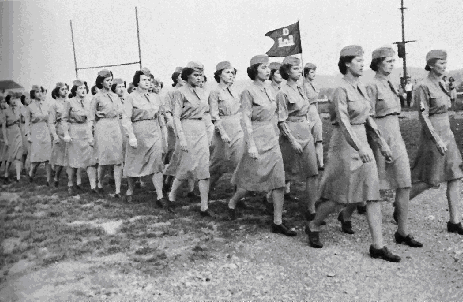 |
| Women's Army Corps (WAC) detachment |
The U.S. government’s effort to produce an atomic bomb during World War II was assigned to the U.S. Army Corps of Engineers in mid-1942. Under the command of then-Brigadier General Leslie R. Groves, the Manhattan Engineer District (MED), based in New York City, began a construction effort that would include production sites across the United States and a workforce of 125,000. The four-year-long project of research and development, completed at a cost of $2 billion, was the most expensive public works project ever undertaken in U.S. history to that point. By the summer of 1945, three atomic bombs were produced, all of which were detonated by the end of the war.
While significant numbers of civilian women served at all of the project sites, most of the women serving in MED were soldiers and officers of the U.S. Army. During World War II, more than 150,000 American women served in the Women's Army Corps (WAC), and WACs assigned to the Corps of Engineers participated in the Manhattan Project. As early as 1943, women soldiers were brought into MED to undertake clerical, technical, and other administrative work. The need for additional personnel led to the establishment of a Manhattan District WAC Detachment on June 3, 1944. By the end of the war more than 400 WACs served in the Manhattan District.
 |
| Capt. Arlene Schneidenhelm |
Job specialties of women assigned to MED included scientists, cryptographers, classified information handlers, metallurgists, electronics technicians, spectroscopists, stenographers, telephone operators, laboratory technicians, nurses, photographers, and clerks. There were a large number of notable women, both WAC and civilian, who worked on the Manhattan Project. The first commanding officer of the WAC detachment was First Lieutenant Frances W. House. She was succeeded by First Lieutenant (later Captain) Arlene G. Scheidenhelm in March 1944. Master Sergeant Elizabeth Wilson ran the cyclotron at Los Alamos. Electronics technician Jane Heydorn helped to develop bomb-testing equipment. Second Lieutenant Catherine Piccolo wrote official press releases explaining why the bombs were used. Physicist Chien Shiung Wu played a key role in developing the gaseous diffusion uranium separation process. Leona Woods monitored the first nuclear chain reaction. Elizabeth Riddle Graves developed a neutron reflector to surround the atom core at Los Alamos. The head of a vital research team, Maria Goeppert Mayer, later received the Nobel Prize in physics.
In commending the WACs for their contributions to MED, on August 9, 1945 Major General Groves wrote, in part: “I wish to express to you, the military personnel of the Manhattan Project, my official and personal appreciation for the industry, ability, and attention to duty under most trying conditions that you have displayed since the inception of the project. Without you, this project could not have achieved success. Your devotion to duty, and particularly your conscientious efforts to maintain the vital security of the project, has been of the highest order.”
 |
|
 |
Women at the controls of the calutrons at Y-12,
the Electromagnetic Separation Plant in Oak Ridge, Tenn. |
|
The alpha calutrons required constant attention
to keep the ion beam at a maximum. |
Special thanks to the Society for the Historical Preservation of the Manhattan Project.
* * *
March 2002. No 46.